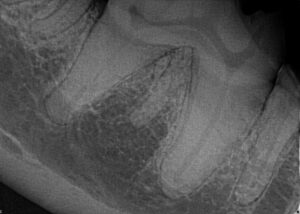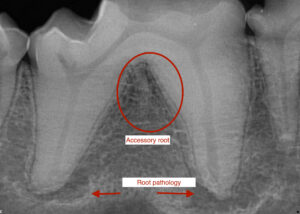10 Dec Interesting Find on a Dog’s Dental X-rays
I recommend dental radiographs on every annual ATP (Assessment, Treatment, Prevention) I perform. Regardless if the visible crown looks good, there could be problems lurking below the gumline. Studies show that almost 3 in 10 dogs and 4 in 10 cats have problems under the gumline that can only be detected by dental radiographs.
Many times, I’ll find an additional tooth root. While this may not be a problem, it is very important to know the underlying anatomy in case this tooth requires any treatment in the future.
Here is a tooth I radiographed recently that has an accessory root (central). While the tooth does not show any pathology, I did note it in the pet’s dental record. If I have to treat this tooth in the future, it is important to know this fact.
Below is an image from a Diplomate friend of mine (Jean Battig in Portland, OR) of a diseased mandibular 1st molar with an accessory root. This tooth must be surgically removed vs having a root canal therapy.
Take home message: Many two rooted teeth may have an accessory roots. Sometimes these teeth have problems, so knowing the root anatomy makes it much easier to extract. Without x-rays, you will leave a diseased root in the mouth that can cause continued oral pain.
Barden Greenfield, DVM, Dipl. AVDC Your Pet Dentist of Memphis and Little Rock




